
Church buildings, as well as any others may be at risk of lightning strike. Therefore, they require a reliable system of external lightning protection. However, the church roof structure not always allows to apply standard solutions to protect against lightning, based on the installation of lightning protection mesh or masts. So what to do? Designers and electricians often think about this question. The situation can be complicated by the additional requirements from the customer.
Anyway, lightning protection for a church is absolutely necessary. We will tell a real example how to do it! Today we will study the calculation of lightning protection for the church in the city of Moscow, which is being reconstructed now.
Objective:
It is necessary to calculate external lightning protection system in accordance with the regulatory documents:
- "Electric Installation code" 7 th ed. Chapter 1.7 (hereinafter EIC);
- "Instructions for organization of lightning protection of buildings, structures and industrial communications"
Industry Standard 153-34.21.122-2003 (hereinafter IS); - "Instructions for lightning protection of buildings and structures" AD 34.21.122-87 (hereinafter AD).
Church buildings are the usual type of structures in terms of lightning protection in accordance with the IS instruction and to the third category according to the AD.
Solution:
Protection of buildings from lightning is carried out with the help of lightning rods. A lightning rod is a device rising above the protective object, through which the lightning current, bypassing the protected object, is drained into the ground. It consists of a lightning rod directly perceiving the lightning discharge, down conductor and ground electrode system. Metal crosses act as lightning rods (for details on the use of the cross as a lightning rod, read here).
The complex of measures on lightning protection if carried out by the following actions:
- Connection of down conductors to the metal crosses on the dome is carried out by means of clips ZZ-005-064.
- Laying of the two down conductors with the use of copper-bonded wire D = 8 mm to the grounding device.
Two down conductors are connected for each lightning rod. Down conductors should be located not closer than 3 m from entrances or in places inaccessible for people's touch. Fixation of down conductors on the roof is carried out with the help of clips GL-11747A. Fixation of a down conductor to vertical surfaces is carried out with the help of clips GL-11703A. Connection and splitting of down conductors is carried out with the help of clips GL-11551M. - Installation of the grounding device, consisting of three vertical electrodes (copper-bonded pins,14 mm in diameter) 3 m long, united by a horizontal electrode (copper-bonded tape 30x4 mm). The distance between the vertical electrodes is not less than 5 meters, the distance from the horizontal electrode to the walls of the building 1 m, depth 0.5 m.
- Connection of the down conductor with the output of the copper-bonded tape from the ground is carried out with the help of a control clamp GL-11562A.
Disposition of lightning protection elements:
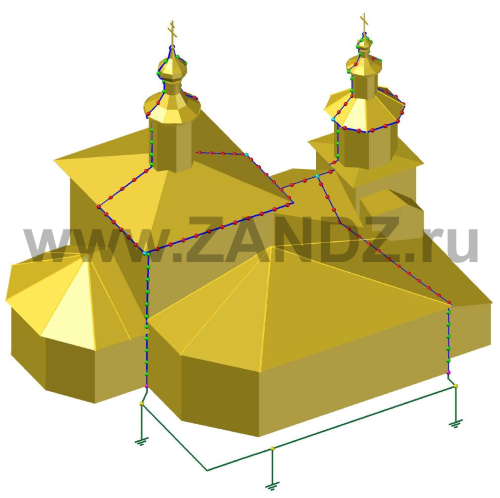
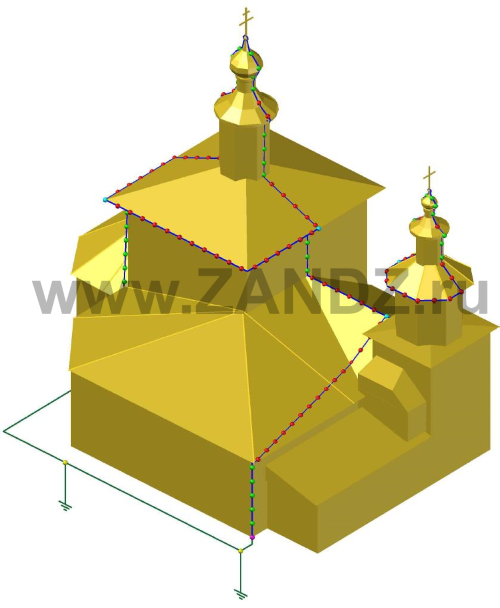
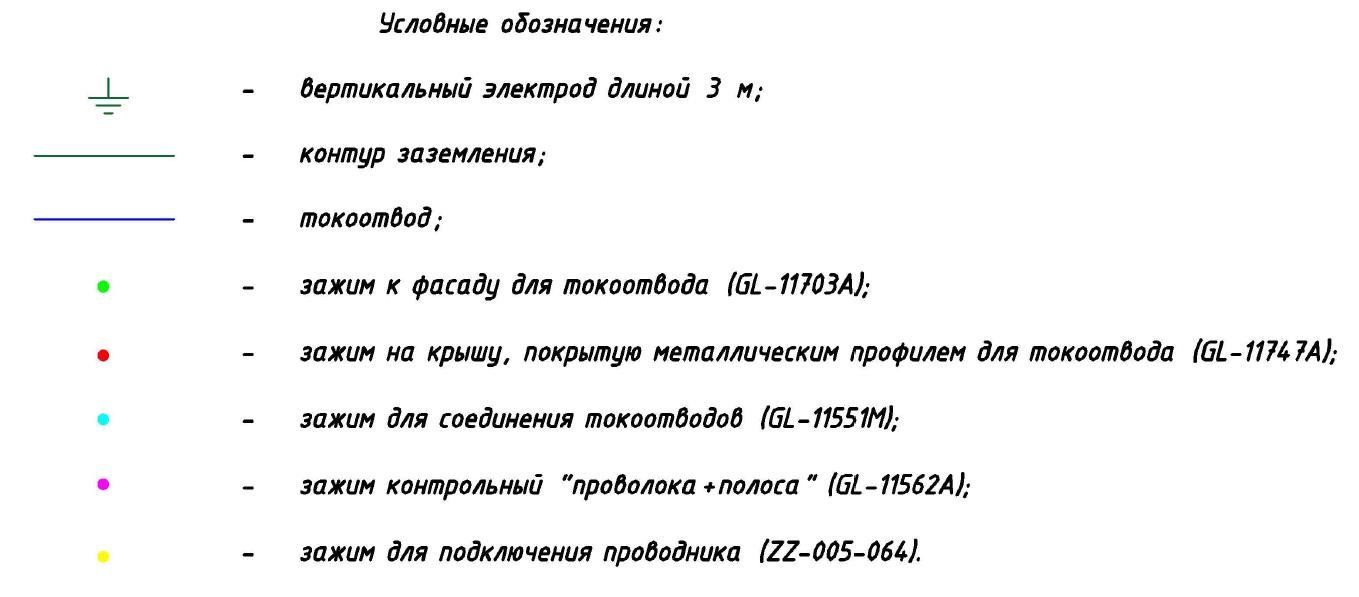
Условные обозначения- notations
Вертикальный электрод длиной 3 м- vertical electrode 3 m long
Контур заземления- grounding contour
Токоотвод – down conductor
Зажим к фасаду для токоотвода- clamp to the façade for the down conductor
Зажим на крышу, покрытую металлическим профилем для- clamp to the roof, covered with metal profile
Зажим для соединения токоотводов – clamp for connecting down conductors
Зажим контрольный проволока+ полоса – Control clamp wire+ tape
Зажим для подключения проводника – clamp for connecting conductor
Protection zone corresponding to the reliability of the zone B AD:
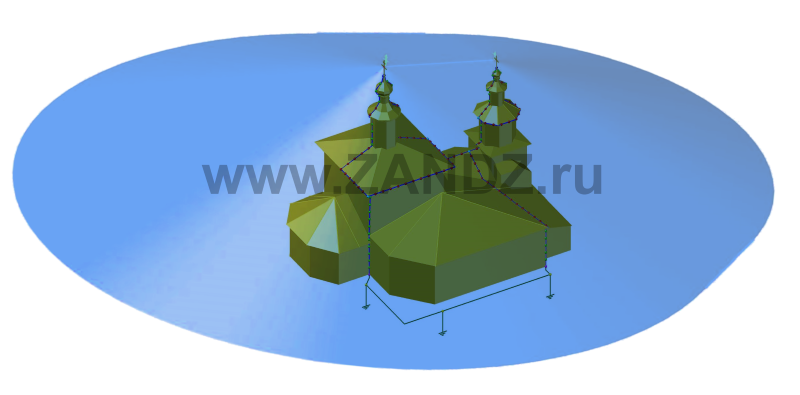
The list of required materials:
Performance of events described in this calculation will provide construction of a reliable protection from direct lightning strikes. It is necessary to use surge protection devices (SPD) to protect from its secondary effects. It is not difficult to choose the desired device. See the SPD selection manual and send us your questions, we will surely answer them! Our contact information is here.
See also:
- We calculate grounding and lightning protection for a temple!
- Article by Professor E.M. Bazelyan "Lightning protection of residential and public buildings"
- Grounding for lightning protection
Related Articles:


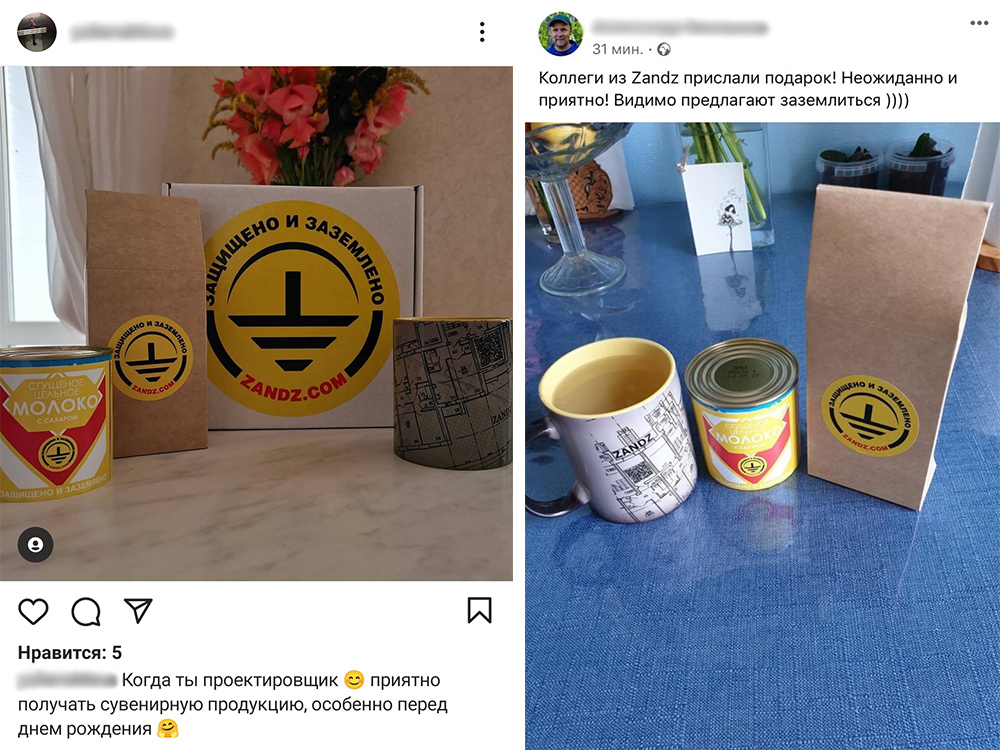
.jpg)






.png)









